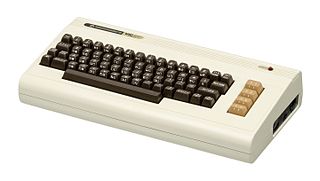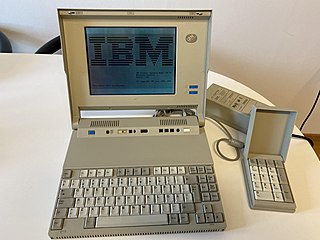
Atari ST is a line of personal computers from Atari Corporation and the successor to the company's 8-bit home computers. The initial model, the Atari 520ST, had limited release in April–June 1985, and was widely available in July. It was the first personal computer with a bitmapped color graphical user interface, using a version of Digital Research's GEM interface / operating system from February 1985. The Atari 1040ST, released in 1986 with 1 MB of memory, was the first home computer with a cost per kilobyte of RAM under US$1/KB.

Fax, sometimes called telecopying or telefax, is the telephonic transmission of scanned printed material, normally to a telephone number connected to a printer or other output device. The original document is scanned with a fax machine, which processes the contents as a single fixed graphic image, converting it into a bitmap, and then transmitting it through the telephone system in the form of audio-frequency tones. The receiving fax machine interprets the tones and reconstructs the image, printing a paper copy. Early systems used direct conversions of image darkness to audio tone in a continuous or analog manner. Since the 1980s, most machines transmit an audio-encoded digital representation of the page, using data compression to transmit areas that are all-white or all-black, more quickly.
Fall back is a feature of a modem protocol in data communication whereby two communicating modems which experience data corruption can renegotiate with each other to use a lower-speed connection. Fall forward is a corresponding feature whereby two modems which have "fallen back" to a lower speed can later return to the higher speed if the connection improves.

The Atari 8-bit computers, formally launched as the Atari Home Computer System, are a series of home computers introduced by Atari, Inc., in 1979 with the Atari 400 and Atari 800. The architecture is designed around the 8-bit MOS Technology 6502 CPU and three custom coprocessors which provide support for sprites, smooth multidirectional scrolling, four channels of audio, and other features. The graphics and sound are more advanced than most of its contemporaries, and video games are a key part of the software library. The 1980 first-person space combat simulator Star Raiders is considered the platform's killer app.

The VIC-20 is an 8-bit home computer that was sold by Commodore Business Machines. The VIC-20 was announced in 1980, roughly three years after Commodore's first personal computer, the PET. The VIC-20 was the first computer of any description to sell one million units, eventually reaching 2.5 million. It was described as "one of the first anti-spectatorial, non-esoteric computers by design...no longer relegated to hobbyist/enthusiasts or those with money, the computer Commodore developed was the computer of the future."
U.S. Robotics Corporation, often called USR, is a company that produces USRobotics computer modems and related products. Its initial marketing was aimed at bulletin board systems, where its high-speed HST protocol made FidoNet transfers much faster, and thus less costly. During the 1990s it became a major consumer brand with its Sportster line. The company had a reputation for high quality and support for the latest communications standards as they emerged, notably in its V.Everything line, released in 1996.

The Amstrad PC1512 was Amstrad's mostly IBM PC-compatible computer system, launched in 1986, and advertised with prices from £399 plus VAT. The system was also marketed in the US by Texas-based Vidco Inc. from the start of 1987. Later in 1987, a slightly updated version called the PC1640 was introduced, also marketed as the PC6400 and Sinclair PC500. Schneider branded machines for the German market were also sold.

Telebit Corporation was a US-based modem manufacturer, known for their TrailBlazer series of high-speed modems. One of the first modems to routinely exceed 9600 bit/s speeds, the TrailBlazer used a proprietary modulation scheme that proved highly resilient to interference, earning the product an almost legendary reputation for reliability despite mediocre line quality. They were particularly common in Unix installations in the 1980s and 1990s.
Hayes Microcomputer Products was a US-based manufacturer of modems. The company is known for the Smartmodem, which introduced a control language for operating the functions of the modem via the serial interface, in contrast to manual operation with front-panel switches. This smart modem approach dramatically simplified and automated operation. Today almost all modems use a variant of the Hayes AT command set.

Gandalf Technologies, Inc., or simply Gandalf, was a Canadian data communications company based in Ottawa. It was best known for modems and terminal adapters that allowed computer terminals to connect to host computers through a single interface. Gandalf also pioneered a radio-based mobile data terminal that was popular for many years in taxi dispatch systems. The rapid rise of TCP/IP relegated many of Gandalf's products to niche status, and the company went bankrupt in 1997; its assets were acquired by Mitel.
The Apple USB Modem is a combined 56 kbit/s data modem and 14.4 kbit/s fax external USB modem introduced by Apple Inc. after the internal 56k modem was dropped on the October 12, 2005 iMac G5 revision. While it looks similar, it should not be confused with Apple's optional USB Ethernet Adapter accessory, available for its MacBook Air and MacBook Pro Retina range of laptops since 2008.
The Microcom Networking Protocols, almost always shortened to MNP, is a family of error-correcting protocols commonly used on early high-speed modems. Originally developed for use on Microcom's own family of modems, the protocol was later openly licensed and used by most of the modem industry, notably the "big three", Telebit, USRobotics and Hayes. MNP was later supplanted by V.42bis, which was used almost universally starting with the first V.32bis modems in the early 1990s.
Microcom, Inc., was a major modem vendor during the 1980s, although never as popular as the "big three", Hayes, U.S. Robotics (USR) and Telebit. Nevertheless, Microcom holds an important place in modem history for introducing the MNP error-correction and compression protocols, which were widely used under license by most modem manufacturers in the 1990s. The company went public in 1987. Compaq purchased publicly outstanding shares of the company in 1997.

Supra Corporation was best known as a manufacturer of modems for personal computers, but also produced a range of hardware for the Amiga and Atari ST, including hard drives, SCSI controllers, memory boards, and processor accelerators.

A modulator-demodulator, commonly referred to as a modem, is a computer hardware device that converts data from a digital format into a format suitable for an analog transmission medium such as telephone or radio. A modem transmits data by modulating one or more carrier wave signals to encode digital information, while the receiver demodulates the signal to recreate the original digital information. The goal is to produce a signal that can be transmitted easily and decoded reliably. Modems can be used with almost any means of transmitting analog signals, from light-emitting diodes to radio.

Home computers were a class of microcomputers that entered the market in 1977 and became common during the 1980s. They were marketed to consumers as affordable and accessible computers that, for the first time, were intended for the use of a single, non-technical user. These computers were a distinct market segment that typically cost much less than business, scientific, or engineering-oriented computers of the time, such as those running CP/M or the IBM PC, and were generally less powerful in terms of memory and expandability. However, a home computer often had better graphics and sound than contemporary business computers. Their most common uses were word processing, playing video games, and programming.
The CompuCom SpeedModem was an early high speed modem that implemented a proprietary 9600 bit/s protocol known as the CompuCom Speed Protocol (CSP). Their modems were much less expensive than competing high-speed models, and were well known for a time. The introduction of low-cost standards-based v.32bis modems made the SpeedModem disappear with surprising speed.
Singapore Teleview or known as Camp-Camp View or Ke Pik was a Singaporean videotext service. In the mid 1980s, the Telecom Authority of Singapore entered into a joint venture development with GEC Marconi in the UK to develop a photo-videotext public service. Selected engineers were sent to the UK to work within the Marconi development team stationed at Fleet, Hampshire, England. Singapore was the first country in the world to launch an interactive information service to the public which included photographic images. The service started trials during late 1987 using specifically designed terminals. Controlled trials had been conducted since 1987 as the infrastructure was installed and trialed successfully. It finally went into full public service in 1991.

The IBM Personal System/2 Model L40 SX is a laptop made by IBM as part of the IBM PS/2 series. It was the successor to the IBM PC Convertible. The "SX" in the name refers to its CPU, the Intel 80386SX.













